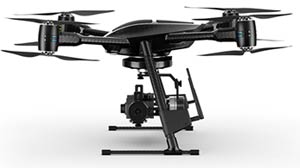Stratasys 3D Printers Decrease Drone D&D Costs
3D Printers Decreasing Drone Design and Development Costs While Catering to Customization
Specialist company deploys 3D printing for both prototype and customized end-use parts production
Unmanned aircraft systems (drones) for civilian commercial applications are one of the most exciting disruptive technologies these days. With more than 200 of its aircraft already in use, Netherlands-based Aerialtronics is poised to offer systems for applications ranging from infrastructure inspection and mapping to livestock monitoring and creative filming for advertising and marketing.
As a small company with only 35 employees, a major challenge for Aerialtronics is to develop systems that could meet the requirements of a variety of industries without dissipating its resources on dozens of discrete designs.
“We have basically developed a concept that uses a standard platform and is customizable to individual customers and applications,” said Joost Hezemans, Head Designer at Aerialtronics. “The result of our development is the Altura Zenith. Specially tailored options include the number and power of motors, the payload capacity, flight times and variations of required software systems.”
Customized pieces including motor housings, different gimbals, as well as boxes and enclosures for hardware and software – all of which need to be designed and prototyped.
“Developing even these limited variations required many design iterations requiring prototype models,” Hezemans said. “The process was slow and expensive.”
As a result, Aerialtronics explored 3D printing as a solution, and subsequently began outsourcing to service bureaus. However, as some of the models were being made in Asia, each iteration was taking about a month to produce, while also putting a strain on budgets.
With the objective of reducing development times and costs, Aerialtronics sought an in-house solution. Working closely with Stratasys, the company ultimately built in-house 3D printing operations with a uPrint SE Plus 3D Printer by Stratasys at the core.
R&D times dive 50%
“Since taking control of our own 3D printing requirements, we have eradicated the lengthy lead times we previously had to endure and have cut our R&D time by about 50 percent,” Hezemans said.
“We liked the ease of operation and how CAD designs could be fed into the Stratasys 3D Printer. The ABSplus material also has the right strength – about 90 percent of final materials – and weight characteristics perfect for us to build a full flying prototype.”
“A further benefit of ABSplus material is that we can use it for the production of customized parts,” Hezemans said. “The motors, for example, can generate a lot of heat, so it’s critical to have a material that can withstand it while also possessing the right strength and weight characteristics. The 3D-printed ABSplus motor mounts have those properties.”
Soaring high with 3D-printed end-use parts
While Aerialtronics always intended to construct the main platform from carbon fiber, it uses 3D printing to produce different types of final-use “add-on” parts that vary in size according to the specific application needs of customers. These typically include 3D-printed parts to house different-sized sensor equipment, video downlink and GPS systems, as well as a variety of boxes to accommodate cabling and electronic components. Using 3D printing also gave designers and engineers more time to refine components.
“With the uPrint 3D printer, we can adjust a design one day and 3D print new parts overnight, test it, tweak it some more, and print another to test the next day,” Hezemans said. “This process means that designs have gone through between five and 10 more iterations than before. We have been able to 3D print more, see more and fly more than previously possible, and thanks to 3D printing, the product is much better.”
Applications? The sky’s the limit
The scope and benefits of commercially available drones promises an influence far beyond fanciful personal delivery systems; Aerialtronics’ aircraft are already in use by police and emergency services, utility companies and other organizations.
The company is also working with the FAA and CAA to ensure regulators fully understand the impact remotely piloted aircraft can have on businesses and to help them develop rules and guidelines that enable effective use of drones in as many industries as possible.
Aerialtronics’ vision of remotely piloted aircraft, developed in close cooperation with end users, is being realized with the use of 3D printing. The technology is also making it possible for a small company like Aerialtronics to compete on an international level by transforming what was previously time consuming and costly to streamlined and cost effective. Like other transformative technologies, the use of drones and 3D printing is not only able to save customers money, but also make them money through their deployment.
“Stratasys’ 3D printing technology helped us advance the design and development of the Altura Zenith drone far more quickly and at a much lower cost than would have been achievable with conventional methods,” Hezemans said. “Using the uPrint SE Plus for design development, prototyping and production of customized parts, we are able to build drones that meet the current and future specifications of our customers – no matter how diverse they might be.”

 Blog
Blog 

